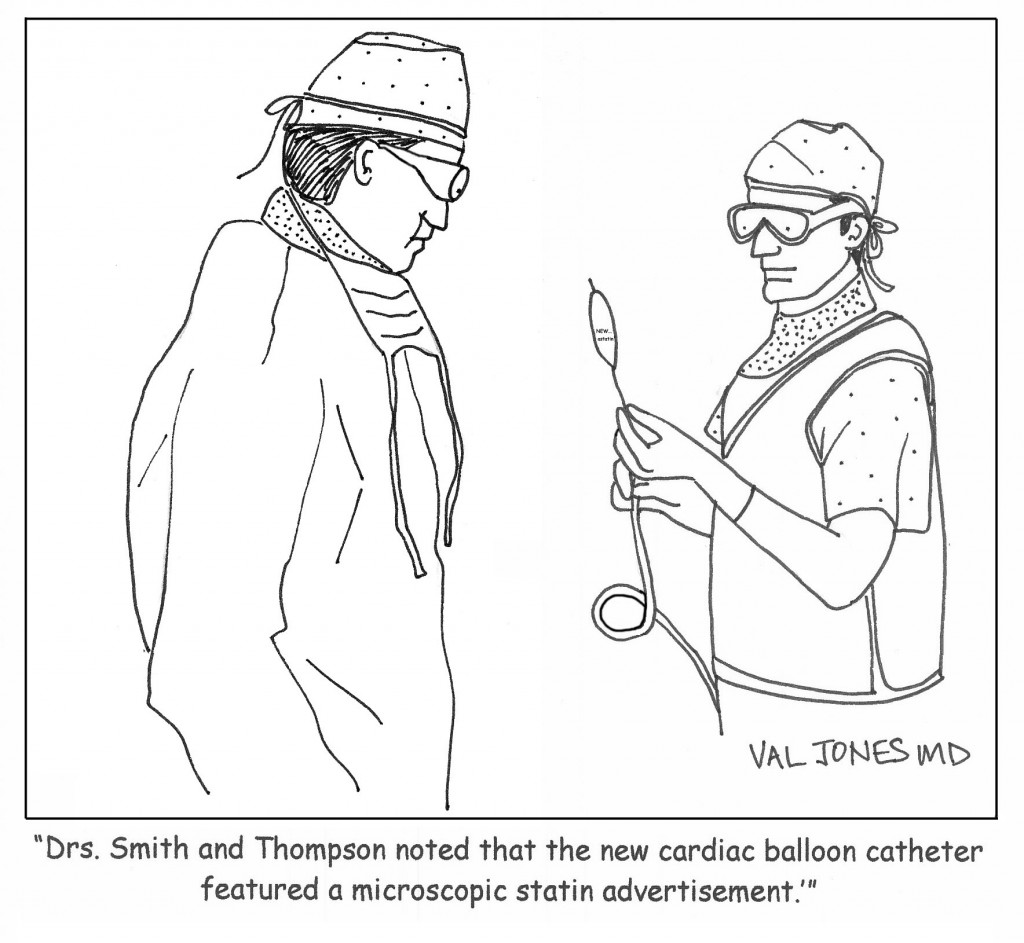December 16th, 2013 by Dr. Val Jones in Opinion
No Comments »
 I am consistently bemused by those who recommend more rigorous or more pervasive standardized testing as the primary means for insuring physician quality. The vast majority of physicians have already passed through a complex gauntlet of multiple choice exams, extended credentialing and certification processes, and lengthy tests of knowledge and skill. And yet, some physicians (to put it bluntly, sorry friends) are very bad at what they do.
I am consistently bemused by those who recommend more rigorous or more pervasive standardized testing as the primary means for insuring physician quality. The vast majority of physicians have already passed through a complex gauntlet of multiple choice exams, extended credentialing and certification processes, and lengthy tests of knowledge and skill. And yet, some physicians (to put it bluntly, sorry friends) are very bad at what they do.
Intellectual intelligence is necessary, but not sufficient, for doctoring. It is emotional intelligence (EI) that is sorely lacking – because it has neither been cultivated, nor selected for, by many training programs. Some educators openly acknowledge the problem, pointing to “extra-curricular activities” as their primary means of distinguishing equally qualified applicants. The disappointing reality is that non-academic performance may be a tie-breaker for students with similar standardized test scores, but raw scores almost always trump any other factor. In the end, we have a physician work force that is highly adept at assimilating and regurgitating facts, but is only accidentally good at human interactions.
Is there hope for change in this arena? I believe that the prognosis is guarded. As our culture becomes more and more digital data-driven, a tsunami of “meaningless use” threatens to drown us all in false quality measures, electronic medical record documentation “quality assurance” requirements, and analysis of trends without comprehension of context or influencing variables outside the scope of the measuring instruments. Lies, damn lies, and statistics. We can’t get enough! And guess who are the biggest proponents of these methods? Why, people who only excel at standardized testing – mostly because their true flaws also lie outside the measuring instruments. Bad doctors (sometimes turned-administrators) themselves are often fueling the onslaught of fruitless quality improvement initiatives.
Dr. Howard Luks, orthopedic surgeon and social media activist, wrote a provocative blog post on the subject of why physicians don’t engage more in social media. He suggests that many avoid it because they lack people-skills in the first place and don’t genuinely enjoy engaging with patients. If you’re a “jerk” in real life, he argues, then what advantage is there to making that more obvious on blogs, Facebook, Twitter, etc.? Better to stay socially quiet.
The interesting thing is that social media might be the most reliable way to discover whether or not your doctor is kind, thoughtful, observant, and detail-oriented. Reading a physician’s thoughts online can help you get to know their true personality and work ethic. In the future it would be nice if medical schools and residency training programs took the time to read applicants’ blogs (for example) instead of crunching their test scores for admission via the path of least resistance. An extra hour of reading up front could save our medical system from a new wave of low EI providers.
As Seth Godin put it, “Uncaring hands are worth avoiding.”
We all recognize the importance of this statement intuitively, but have a hard time quantifying “caring” with standardized tests. That’s why admissions officers and patients alike must use their judgment when selecting doctors. We pay verbal homage to the importance of “clinical judgment” in medicine but in reality are culturally afraid of straying from numbers to support our decision-making.
How will you know a good doctor? You’ll know him [or her obviously] when you see him. And sometimes you can see him best on social media platforms.
***
A few caveats of course:
1. Social Media is a sensitive but not specific test. Meaning, you can probably accurately identify caring doctors from their blogs, etc. but if they don’t have one, it doesn’t mean they aren’t good/caring.
2. It may not matter if you find a great doctor online if they’re not in your limited ACA network. 😕
3. Direct primary care is a potentially excellent way to get connected to exceptional doctors. I am a fan of this movement and have been actively involved in a practice in VA. The practices can reduce costs and enhance quality care, though recent caps on Health Savings Accounts (initiated by the Obama administration) have reduced consumer freedom to spend pre-tax income on direct primary care.
December 12th, 2013 by Dr. Val Jones in Health Tips
1 Comment »
 I’m very excited to be the nutrition coach for the Boys & Girls Clubs’ Fit Family Challenge again this year. In surveying the finalist families, I discovered that the two most important nutrition issues on their minds were cooking speed and food affordability. Far down the list were things like food allergies, weight loss, and nutrition basics.
I’m very excited to be the nutrition coach for the Boys & Girls Clubs’ Fit Family Challenge again this year. In surveying the finalist families, I discovered that the two most important nutrition issues on their minds were cooking speed and food affordability. Far down the list were things like food allergies, weight loss, and nutrition basics.
Contrary to popular belief, healthy eating doesn’t have to be expensive. A new study showed that a healthful diet only costs an average of $1.50/day more than an unhealthy diet, and the additional cost is mostly related to the expense of leaner protein sources. So with a little bit of shopping savvy, you can change your family’s nutrition without breaking the bank.
Since busy moms and dads are always looking for ways to provide fast, nutritious meals for their children, I thought I’d provide some tips for doing so on a budget. These are strategies that I also use when I’m traveling across the country, working long hours at hospitals with only a microwave and small refrigerator available, and very little time for meal prep. If your day is frantic, and you don’t have much time to cook, then these tips are for you! (I’m not saying we’re going to win any culinary awards for these meals, but they are very practical. Please use your own favorite herbs and spices for flavor. I have added links throughout this post to show you examples of products I’ve used and like – but there are many other good ones out there!) 😀
1. Tupperware. Make sure you have lots of plastic storage containers (Tupperware or other brand) and baggies in various sizes. You can reuse the containers and portion out food into single serving sizes in advance. Don’t worry about finding containers that are “BPA-free” – they may cost more and fifty+ years of scientific studies (reviewed by the U.S. Food and Drug Administration) have determined that they are safe for microwave use and food storage.
2. Prepare meals ahead of time. Set aside one day a week where you will fill containers and baggies with single serving sizes of 1) protein, 2) fruits/veggies, 3) nuts/fats, and 4) complex carbohydrates. Each meal should include one of each. Snacks can contain two or three of the four groups. Each family member can quickly grab portions for their meals, lunch boxes, or snacks, and you can make up plates for dinner by reheating them in the microwave.
3. Fast protein. Pre-cooked, grilled chicken or turkey strips can be found in the refrigerated or frozen section of your local discount store. Four ounces of grilled chicken is a good serving size, and make sure you choose the chicken without sauce or chemical flavorings as your healthiest option. One serving takes about a minute to reheat in the microwave. Other great sources of protein include plain Greek yogurt (a serving is 1 cup), protein powder (whey, egg, or vegan sources), pre-packed hard-boiled eggs, canned tuna or fish in water, smoked salmon, and low-fat cheese sticks.
If you have a stove and 4-8 minutes to spare, quick-fry pork chops, lean beef, fish fillets, or egg beaters (plain, liquid egg whites in a carton are even better) with low-fat shredded cheese with a few chopped veggies can make a great omelet that’s fast and affordable.
You can make egg whites in a microwave (spray a microwave container with a little bit of pure olive oil cooking spray) and cook for one and a half minutes per serving. Top with salt, pepper, cheese, and maybe a little ketchup if you like that. Super fast, super healthy.
In a pinch, beef, pork, and natural turkey jerkies are very portable protein sources. However, they can be expensive, and you must look for the all natural varieties (not the jerky full of salt and chemicals at various truck stops across the country).
4. Fast fruits & veggies. Fruits are pretty easy because you can chop them up or peel them quickly, but if you don’t want to chop them too far in advance, pre-made fruit cups are a little more expensive, but very convenient. Make sure you choose the fruit that is packed in its own juice, not syrup.
As far as veggies are concerned, some can be enjoyed raw (celery, carrot sticks, lettuce, tomatoes etc.) but others need cooking. The fastest way to cook most fresh veggies is to steam them in a microwave. Stores now pack veggies (such as green beans, broccoli, and snow peas for example) in “steam-in bags” where you can just puncture the bag with a fork and then microwave the veggies for a couple of minutes. If you’re buying veggies in bulk, you can purchase “Zip n’ Steam” bags and use those instead. I’ve used these bags for everything from butternut squash to corn on the cob. They lock in all the vitamins and minerals that you may loose in a boiling or canning process.
Otherwise, frozen veggies are very convenient and are pre-chopped. Canned vegetables are also rich in vitamins (though they tend to lose the water soluble A&B vitamins so you’ll need to get those from your fruits or a squeeze of lemon in your water) and very easy to heat and are affordable.
5. Fast fat. Mostly, what I mean by healthy fats is nuts, seeds, and vegetable oils (especially olive). Fats are rarely cost-prohibitive and it doesn’t take much to “prepare” them. Healthier nuts and nut butters are plain (no sugar or salt added). Avoid candy-coated nuts, sugary spreads, or trail mixes that have “yogurt-covered” anything or chocolate added. Go easy on the dried fruit as it is a simple sugar. Cook with olive oil or olive oil spray when you can. Limit your animal fat intake (butter, high-fat cheese, lard, bacon) as it is not as healthy for you as vegetable sources.
6. Fast complex carbohydrates. I’m a big fan of brown rice. It’s very inexpensive and reheats well with a little moisture in the microwave. You can purchase the rice dry (this is the most affordable way, but you’ll need to cook up a big batch once a week), or pre-cooked in microwavable bags or containers. Brown rice grits, corn grits, cream of wheat, and oats all make quick, microwavable portions of carbs. Whole grain tortillas take 15 seconds to heat in the microwave and can be used as a wrap or side-dish. Whole grain breads, sugar-free whole wheat cereal, canned beans, hummus, and sweet potatoes (not in syrup) are all fast and affordable.
7. Drink water. It’s free, it’s everywhere, it has no calories. Water is the healthiest fluid source available, so make use of it. To save money, you can re-use plastic water bottles by refilling them with tap water. If your tap water doesn’t taste great, a squirt of fresh lemon or lime juice (along with keeping it colder) should solve the problem. Sugary sodas, juices, and energy drinks should be limited. Club soda, sparkling water, or diet sodas are a better choice if you are craving carbonation. Skim milk, almond, rice, or soy milk are healthy options as well.
8. Buy in bulk. So now that we have broken down the healthy, affordable diet into its four components and fluids – it’s time to stock up! Buying large quantities of your favorite non-perishable items can save money. Consider cost-sharing with another family, coupon-clipping, and price-shopping. Some items that you normally don’t think of as frozen goods actually store very well in the freezer – bread, tortillas, nuts, and bananas for example can last for months in the freezer. For a review of the best grocery items to buy in bulk, see this slide show.
9. Skip the organic food. Organic products are very expensive and do not provide a significant nutritional advantage over regular foods. You may wish to buy organic food to support your local farmers or because the items are fresher-looking or their packaged goods may have fewer preservatives or added ingredients, but don’t spend your last penny on organic foods because you think it’s the only way to keep your kids well-nourished. As far as reducing your potential exposure to pesticides, organic foods may reduce pesticide exposure by 30%, not exactly the “pesticide-free” level that some would lead you to believe. Most experts (including the FDA) agree that the amount of potential pesticide residue found on fresh fruit and vegetables is too low to pose a significant risk human health. Washing fresh produce with soap and water, or removing the skin, can further reduce levels if you have concerns.
10. Don’t waste money on vitamins and supplements. Although it seems like a good idea to provide your children with extra vitamins in pill-form, the majority of U.S. children and adults (according to large CDC nutrition studies) are not deficient in any vitamin or mineral. Our fortified food sources, even with sub-optimal diets, are doing a surprisingly good job of getting us all the nutrition we need. If your doctor has determined that you or a family member has a nutritional deficiency, then please follow their advice regarding supplementation. As for herbal supplements, be very careful of those since recent studies have shown that they often don’t contain the active ingredients on their labels and may even contain harmful allergens instead.
There are probably many other terrific ideas that you’ve discovered on the path to feeding your family quickly and affordably. Please share them on the blog so we can expand our creative meal planning together! I’ll be thinking of the Fit Family finalists as I enjoy my brown rice and green pepper chicken fajitas in my hospital microwave this week!
December 9th, 2013 by Dr. Val Jones in Opinion, True Stories
1 Comment »
 Over the years that I’ve worked in acute inpatient rehab centers, I have been truly vexed by a particular type of patient. Namely, the stubborn patient (usually an elderly gentleman with a military or armed forces background). I know that it’s not completely fair to generalize about personality types, but it seems that the very nature of their work has either developed in them a steely resolve, or they were attracted to their profession because they possessed the right temperament for it. Either way, when they arrive in the rehab unit after some type of acute illness or traumatic event, it is very challenging to cajole them into health. I suspect that I am failing quite miserably at it, frankly.
Over the years that I’ve worked in acute inpatient rehab centers, I have been truly vexed by a particular type of patient. Namely, the stubborn patient (usually an elderly gentleman with a military or armed forces background). I know that it’s not completely fair to generalize about personality types, but it seems that the very nature of their work has either developed in them a steely resolve, or they were attracted to their profession because they possessed the right temperament for it. Either way, when they arrive in the rehab unit after some type of acute illness or traumatic event, it is very challenging to cajole them into health. I suspect that I am failing quite miserably at it, frankly.
Nothing is more depressing for a rehab physician than to see a patient decline because they refuse to participate in activities that are bound to improve their condition. Prolonged immobility is a recipe for disaster, especially in the frail elderly. Refusal to eat and get out of bed regularly can make the difference between life and death within a matter of days as leg clots begin to form, and infectious diseases take hold of a body in a weakened state. The downward spiral of illness and debility is familiar to all physicians, but is particularly disappointing when the underlying cause appears to be patient stubbornness.
Of course, the patient may not be well enough to grasp the “big picture” consequences of their decisions. And I certainly do not pretend to understand what it feels like to be elderly and at the end of my rope in regards to prolonged hospital stays. Maybe I’d want to give up and be left alone too. But it’s my job to get them through the tough recovery period so they can go home and enjoy the highest quality of life possible. When faced with a patient in the “wet cat” phase of recovery (I say “wet cat” because they appear to be as pleased to be on the rehab unit as a cat is to being doused against their will), these are the usual stages that I go through:

1. I explain the factual reasons for their admission to rehab and what our goals are. I further describe the risks of not participating in therapies, eating/drinking, or learning the skills they need to care for themselves with their new impairments.
2. I let them know that I’m on their side. I understand that they don’t want to be here, and that I will work with them to get them home as soon as possible, but that I can’t in good conscience send them home until it’s safe to do so.
3. I give them a projected discharge date to strive towards, with specific tasks that need to be mastered. I try my best to give the patient as much control in his care as possible.
4. I ally with the family (especially their wives) to determine what motivates them, and request their presence at therapy sessions if that seems fruitful rather than distracting. (Helpful spouse input: “Mike only wants to walk with me by his side, not the therapist.”)
5. I ask loved ones how they think the patient is doing/feeling and if there is anything else I can do to make his stay more pleasant. (Helpful input: “John loves ice cream. He hates eggs” or “John usually goes to bed at 9pm and gets up at 4am every day.”)
6. I meet with nursing and therapy staff to discuss behavioral challenges and discuss approaches that are more effective in obtaining desired results. (For example, some patients will always opt out of a task if you give them a choice. However, they perform the task if you state with certainty that you are going to do it – such as getting out of bed. “Would you like to get out of bed now, Mr. Smith?” will almost certainly result in a resounding “No.” Followed perhaps by a dismissive hand wave. However, approaching with a “It’s time to get out of bed now, I’m helping you scoot to the edge of the bed and we’re going to stand up on 3. One, two, three!” Is much more effective.)
7. If all else fails and the patient is not responding to staff, loved ones, or doctors, I may ask for a psychiatric consult to determine whether or not the patient is clinically depressed or could benefit from a medication adjustment. Typically, these patients are vehemently opposed to psychiatric evaluation so this is almost the “nuclear” option. Psychiatrists can be very insightful regarding a patient’s mindset or barriers to participation, and can also help to tease out whether delirium versus dementia may be involved, and whether the patient lacks capacity to make decisions for himself.
8. If the patient still does not respond to further tweaks to our approach to therapy or medication regimen, then I begin looking for alternate discharge plans. Would he be happier in a skilled nursing home environment where he can recover at a slower rate? Would he be amenable to an assisted living or long term care facility? (The answer is almost always a resounding “no!”) Is the patient well enough to go home with home care services and round-the-clock supervision? Does the family have enough support and can they afford this option?
9. At this point, after exhausting all other avenues, if the patient is still declining to move or eat or be transferred elsewhere, some sort of infection might set in. A urinary tract infection, a pneumonia, or bowel infection perhaps. Then the patient becomes febrile, is started on antibiotics, becomes weaker and less responsive, and is transferred to the medicine floor or higher level of care. Alternatively at this phase (if he is lucky enough not to become infected) the patient might have a cardiac event, stroke, blood clot with pulmonary embolus (especially if he is a large man), kidney failure, or develop infected pressure ulcers. Any of which can be cause for transfer to medicine. In short, if you stay in the hospital long enough, you can find a way to die there.
10. After much hand-wringing, angst, and generalized feelings of helplessness the wives and I review the course of events and ask ourselves if we could have done anything differently. “If I had acted like a drill sergeant, do you think he would have responded better?” I might ask. “No dear, that would only have made things worse.” She’ll reply. I’ll see how disappointed she is in his deterioration, staring off towards pending widowhood, engaging in self-blame and what-ifs (E.g. “If we had only had more money perhaps we could have taken him home with 24 hour nursing care until he was better…” “If I had cooked all his meals, maybe he would have gained enough strength to avoid the infection…” etc.) I try to be reassuring that none of this would have made a difference, myself reeling from the failure to get the patient home.
This 10 step process happens far more often than I’d like, and I certainly wish there were a way to head off the downward spiral with some kind of effective intervention. Would it help to have a volunteer unit of ex-military peer counselors in the hospital who could visit with my patients and help to motivate them to get better? (Operation “wet cat” perhaps?) Should I change my approach and put on my drill sergeant hat at the earliest stages of recovery to force these guys out of bed? Can educating younger law enforcement and military workers about illness help to prepare them to be more compliant patients one day?
I don’t know the cure for stubbornness, but it sure leaves a lot of widows in its wake.
November 25th, 2013 by Dr. Val Jones in Humor
No Comments »
With the new guidelines for prescribing cholesterol-lowering medications, I’ve been wondering if perhaps we’re becoming overexposed to these drugs? 🙂

October 23rd, 2013 by Dr. Val Jones in Health Tips, Opinion
1 Comment »
 I realize that my blog has been littered with depressing musings on healthcare lately, and so I thought I’d offer up one very positive and “actionable” suggestion for all you patients out there. In the midst of a broken system where your doctor is being pressured to spend more time with a computer than listening and examining you, where health insurance rates and co-pays are sky-rocketing, and where 1 in 5 patients have the wrong diagnosis… There is one “magic” question that you should be asking your physician(s):
I realize that my blog has been littered with depressing musings on healthcare lately, and so I thought I’d offer up one very positive and “actionable” suggestion for all you patients out there. In the midst of a broken system where your doctor is being pressured to spend more time with a computer than listening and examining you, where health insurance rates and co-pays are sky-rocketing, and where 1 in 5 patients have the wrong diagnosis… There is one “magic” question that you should be asking your physician(s):
“What else could this be?”
This very simple question about your condition/complaint can be extremely enlightening. Physicians are trained to develop extensive “differential diagnoses” (a list of all possible explanations for a set of signs and symptoms) but rarely have time to think past possibilities 1 through 3. That’s one of the reasons why so many patients have the wrong diagnosis – which is both costly in terms of medical bills, time, and pain and suffering.
There is a risk in asking this question – you don’t want to be over-tested for conditions that you are unlikely to have, of course. But I maintain that the cost/risk of living with the wrong diagnosis far exceeds the risk of additional testing to confirm the correct diagnosis. So my advice to patients is to keep this very important question in mind when you see your doctor for a new concern.
In addition to asking this question of your doctor, you can also ask it during a second opinion meeting with another physician. The good news is that these days you don’t even need to get a second opinion in person. I myself have been working with an online second-opinion service called eDocAmerica for several years. Those who sign up for the service can pick the brains of board-certified U.S. physicians on any subject, 24-7 via email (and in some states via phone). The cost is extraordinarily reasonable when provided by employers, and winds up being about one or two dollars per member per month.
If you have a complicated disease or condition (such as cancer) where experts may not all agree on the best treatment plan, a company called Best Doctors offers detailed chart reviews and second opinions from top specialists at academic centers. Again, this service is quite affordable and reasonable if the cost is spread among a group. Employers are able to pay a small fee per employee per month to enroll the entire company in the service.
So why don’t all employers offer these benefits? I suspect that part of the reason is lack of awareness that second opinion services exist, and the other part is tepid demand on the part of employees. So if you’d like to make sure that you’re not one of the five people who have the wrong diagnosis, why not raise the question with your HR department? Enrolling as an individual is also an option, and still as inexpensive as about thirty dollars a month.
My bottom line: make sure you ask your doctor the magic question at least once for every new concern that you have. And if you’re too shy to do it, or your doctor’s answer seems too short, then get a second opinion online or in person.
This one little question could save your life.
 I am consistently bemused by those who recommend more rigorous or more pervasive standardized testing as the primary means for insuring physician quality. The vast majority of physicians have already passed through a complex gauntlet of multiple choice exams, extended credentialing and certification processes, and lengthy tests of knowledge and skill. And yet, some physicians (to put it bluntly, sorry friends) are very bad at what they do.
I am consistently bemused by those who recommend more rigorous or more pervasive standardized testing as the primary means for insuring physician quality. The vast majority of physicians have already passed through a complex gauntlet of multiple choice exams, extended credentialing and certification processes, and lengthy tests of knowledge and skill. And yet, some physicians (to put it bluntly, sorry friends) are very bad at what they do.

 I’m very excited to be the nutrition coach for the Boys & Girls Clubs’
I’m very excited to be the nutrition coach for the Boys & Girls Clubs’  Over the years that I’ve worked in acute inpatient rehab centers, I have been truly vexed by a particular type of patient. Namely, the stubborn patient (usually an elderly gentleman with a military or armed forces background). I know that it’s not completely fair to generalize about personality types, but it seems that the very nature of their work has either developed in them a steely resolve, or they were attracted to their profession because they possessed the right temperament for it. Either way, when they arrive in the rehab unit after some type of acute illness or traumatic event, it is very challenging to cajole them into health. I suspect that I am failing quite miserably at it, frankly.
Over the years that I’ve worked in acute inpatient rehab centers, I have been truly vexed by a particular type of patient. Namely, the stubborn patient (usually an elderly gentleman with a military or armed forces background). I know that it’s not completely fair to generalize about personality types, but it seems that the very nature of their work has either developed in them a steely resolve, or they were attracted to their profession because they possessed the right temperament for it. Either way, when they arrive in the rehab unit after some type of acute illness or traumatic event, it is very challenging to cajole them into health. I suspect that I am failing quite miserably at it, frankly.

 I realize that my blog has been littered with
I realize that my blog has been littered with 







